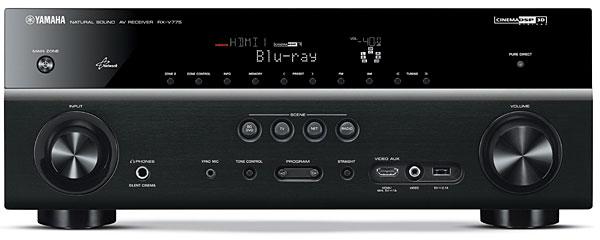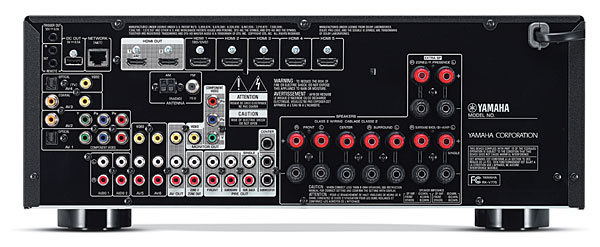Yamaha RX-V775WA AV Receiver

AT A GLANCE
Plus
Wi-Fi adapter supplied
AirPlay built in
iOS-USB and MHL-HDMI
Minus
Bluetooth adapter is optional
THE VERDICT
Great sound and no-extra-charge Wi-Fi functionality for well under a thousand bucks.
“There may be said to be two classes of people in the world; those who constantly divide the people of the world into two classes, and those who do not.” Robert Benchley’s Law of Distinction might also apply to audio/video receivers as they vie for the attention of two warring tribes, the Apple tribe and the anything-but-Apple tribe. For Apple loyalists, the Yamaha RX-V775WA offers AirPlay wireless connectivity, a front-panel USB jack into which you can plug any recent iOS device, and an iOS-speaking control app. But for those outside the Apple universe, the receiver also offers Bluetooth wireless connectivity (with optional adapter), a front-panel MHL-compliant HDMI jack for Android smartphones and tablets, and control apps that speak either Android or its Kindle Fire dialect. Basically, whether you’re using a wireless or wired connection to stream to the receiver from your smartphone or tablet of choice, you’re covered. You can also use that device to control the receiver. And even as you do all this, you can be a member of either the Apple or Android tribe, or even change tribes at will. Oh, and have I mentioned the free Wi-Fi adapter?
Between the Lines
Now swing your gaze from consumer tribes to Yamaha-specific sects. Yamaha’s Website includes four AVR lines. The RX-V775WA, under review here, tops the RX-V line, with five new models ending in the numerals -75, selling for $300 to $850. The RX-V775WA is one of a small but growing number of receivers that are triple wireless ready: AirPlay, Bluetooth, and Wi-Fi. AirPlay is built in. Bluetooth requires the extra-cost YBA-11 adapter ($70). Wi-Fi comes by way of a supplied Wi-Fi adapter (YWA-10, $100 when sold separately). The RX-V775WA is the only RX-V receiver to include the Wi-Fi adapter free of charge; for the others it is an option. These arrangements are a little more awkward than having all three features baked in. But Yamaha gets the three jobs done. Other network audio features include Pandora, Rhapsody, Spotify, vTuner, and DLNA for media sharing via PC or NAS drive.
The RX-V775WA is the only RX-V model to support eight-point YPAO—in other words, its auto setup and room correction program can measure from eight points in the room. The RX-V775WA and RX-V675 share another YPAO distinction: an R.S.C. (Reflected Sound Control) that attempts to compensate for speaker placement close to walls. Audiophile-approved placement, away from walls, is not possible in every home, so this might be helpful to some. The two top receivers also share a Dialog Lift control that aims to clarify speaking voices in movies (my listening notes were full of references to excellent vocal reproduction). And they control the second zone from the control app. If you’re more likely to be using a PC while the receiver is running, there’s also Web browser control.
Like all the RX-V models, the RX-V775WA has 4K and 3D passthrough. But only the RX-V775WA and RX-V675 have 4K upscaling. They also have OSD overlay: The onscreen display becomes a semi-transparent layer that doesn’t obliterate other onscreen content. Other video-related features include an HDMI standby through mode that passes the signal from source component to TV even when the receiver is in standby mode—a convenient way to watch the news without powering up the receiver. In similar spirit, for video gamers, a video direct mode bypasses the video processor to speed up the action by two frames, keeping fast-moving images, twitchy trigger fingers, and sound in sync.

Connectivity includes six HDMI inputs and two outputs. Counting the component video output, you might hook up as many as three HD displays. There are also two component video inputs, five composite video ins and two outs, four digital ins (two optical, two coaxial), four stereo analog ins and two outs, and a 7.1-channel (plus extra subwoofer) set of preamp outs. This is a more complete suite than you’d find on a $600 receiver. Although those extra legacy jacks may be of questionable value to many users, the preamp outs would allow the receiver to serve as a preamp/processor with a multichannel amp, if that’s among your future aspirations.
Associated equipment included five Paradigm Reference Studio 20 v.4 speakers, Oppo BDP-83SE universal disc player, Micro Seiki BL-21 turntable, Shure V15MxVR/N97XE cartridge, Onix OA 21s integrated amp serving as phono preamp, Lenovo Win 7 laptop running Foobar 2000, Meridian Direct USB DAC, Lenovo Win 7 desktop PC, and iPad 2. All movie demos were Blu-ray Discs with DTS-HD Master Audio soundtracks.
Top of the World
The RX-V775WA was the kind of receiver that puts me in a good mood. Its top end was, at this price, exceptionally transparent, detailed, open, and listenable. Midrange was fully fleshed out and well proportioned with no undue emphasis or gauze. Purist that I am, I nearly always used Yamaha’s “straight” mode, which uses room correction but no additional processing. However, when I switched in Yamaha’s “standard” mode (“based on the concept of the ideal movie theater”), the receiver’s luscious mid- to high-frequency personality became more of a good thing with no added artificiality. Non-reviewers should give it a try. Bass was well controlled with room correction and the bass-managed sub, and when I shut down all the processing for pure two-channel listening, the receiver’s bottom-end performance was reasonably solid. That’s not something you can take for granted in under-$1,000 receivers.
Seeing these superlatives, readers might wonder why they should pay more than $850, today’s price of admission, for a receiver. The answer would be dynamic headroom. This receiver worked hard (requiring roughly 60 percent of its maximum volume setting) to power my speakers of average efficiency to action-movie levels in my modest-sized room; a good $2,000 receiver would get by with power to spare on these speakers in an even larger room.
The Awakening is a standard supernatural thriller about a ghost hunter at a Victorian boarding school. The receiver’s rich (but not overdone) bass presentation let male voices be deep, rich, and sonorous, even to the point of being slightly localizable in the sub. Female vocals, including that of the ghost hunter, were equally rich but less localizable. A string-orchestra passage in the score got similar treatment, giving it a pleasing weight and warmth, and when the score went into full-throttle male and female choral lamenting, the result was dramatic and nourishing.






























































